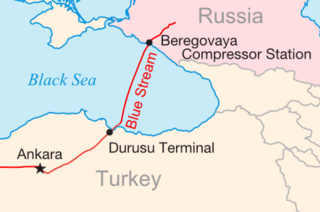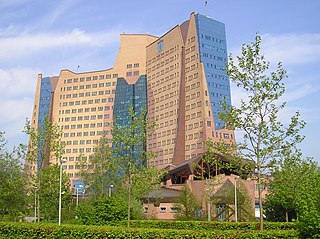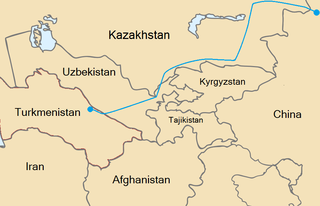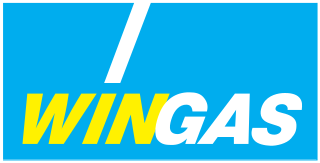Related Research Articles
Induced seismicity is typically earthquakes and tremors that are caused by human activity that alters the stresses and strains on Earth's crust. Most induced seismicity is of a low magnitude. A few sites regularly have larger quakes, such as The Geysers geothermal plant in California which averaged two M4 events and 15 M3 events every year from 2004 to 2009. The Human-Induced Earthquake Database (HiQuake) documents all reported cases of induced seismicity proposed on scientific grounds and is the most complete compilation of its kind.
The Shtokman field, one of the world's largest natural gas fields, lies in the northwestern part of the South Barents Basin in the Russian sector of the Barents Sea, 600 kilometres (370 mi) north of Kola Peninsula. Its reserves are estimated at 3.8 trillion cubic metres of natural gas and more than 37 million tons of gas condensate.
The Sakhalin-2 project is an oil and gas development in Sakhalin Island, Russia. It includes development of the Piltun-Astokhskoye oil field and the Lunskoye natural gas field offshore Sakhalin Island in the Okhotsk Sea, and associated infrastructure onshore. The project is managed and operated by Sakhalin Energy Investment Company Ltd..

Blue Stream is a major trans-Black Sea gas pipeline that carries natural gas to Turkey from Russia. The pipeline has been constructed by the Blue Stream Pipeline B.V., the Netherlands based joint venture of Russian Gazprom and Italian Eni. The Blue Stream Pipeline B.V. is an owner of the subsea section of pipeline, including Beregovaya compressor station, while Gazprom owns and operates the Russian land section of the pipeline and the Turkish land section is owned and operated by the Turkish energy company BOTAŞ. According to Gazprom the pipeline was built with the intent of diversifying Russian gas delivery routes to Turkey and avoiding third countries.

Nord Stream is a pair of offshore natural gas pipelines in Europe that run under the Baltic Sea from Russia to Germany. It comprises the Nord Stream 1 (NS1) pipeline running from Vyborg in northwestern Russia, near Finland, and the Nord Stream 2 (NS2) pipeline running from Ust-Luga in northwestern Russia near Estonia. Both pipelines run to Lubmin in the northeastern German state of Mecklenburg-Vorpommern. Each pipeline comprises two pipes, denoted A and B; each of the four pipes is approximately 1,200 kilometres (750 mi) long and with approximate diameters of 1,220 millimetres (48 in). The combined capacity of the four pipes is 110 billion cubic metres per annum of natural gas.
The BBL Pipeline is a natural gas interconnector between the Netherlands and the United Kingdom.
Novatek is Russia's second-largest natural gas producer, and the seventh-largest publicly traded company globally by natural gas production volume. The company was originally known as OAO FIK Novafininvest. Novatek is based in the Yamalo-Nenets Autonomous Region in West Siberia, and maintains a sales office in Moscow. In the 2020 Forbes Global 2000, Novatek was ranked as the 316th-largest public company in the world.

Medgaz is a submarine natural gas pipeline between Algeria and Spain.

N.V. Nederlandse Gasunie is a Dutch natural gas infrastructure and transportation company operating in the Netherlands and Germany. Gasunie owns the Netherlands gas transmission network with a total length of over 12,000 kilometres (7,500 mi) and 3,100 kilometres (1,900 mi) long network in Germany.

The Central Asia–China gas pipeline is a natural gas pipeline system from Central Asia to Xinjiang in the People's Republic of China. By connecting Turkmenistan to China’s domestic grid, this pipeline makes it possible to transport gas some 7000 km from Turkmenistan to Shanghai. More than half of Turkmen natural gas exports are delivered to China through the pipeline.
The Urucu–Manaus pipeline is a natural gas pipeline in Brazil. It allows use of the natural gas from Urucu, which is the largest onshore natural gas reserve in Brazil. The gas is used to substitute diesel and fuel oil for the electricity production in the state of Amazonas, and the pipeline supplies cities of Coari, Codajás, Anori, Anamã, Caapiranga, Manacapuru, Iranduba, and Manaus. The pipeline was inaugurated on 26 November 2009, and it is operated by Transportadora Urucu-Manaus S.A., a subsidiary of Petrobras.

South Stream was a canceled pipeline project to transport natural gas of the Russian Federation through the Black Sea to Bulgaria and through Serbia, Hungary and Slovenia further to Austria. It was never finished.

Yemen LNG is the first natural gas liquefaction (LNG) project in Yemen. The LNG plant is located in Balhaf.

Wingas GmbH is a gas distribution company located in Kassel, Germany. It is a subsidiary of Gazprom, which held its shares through W&G Beteilligungs-GmbH & Co. KG.

Haidach gas storage is an underground natural gas storage in the town of Haidach near Salzburg, Austria. As of the end of 2018 with a capacity of ~2.9 billion cubic meters (bcm) it is the third largest gas storage facility in Central Europe.
Yamal project, also referred to as Yamal megaproject, is a long-term plan to exploit and bring to the markets the vast natural gas reserves in the Yamal Peninsula, Russia. Administratively, the project is located in the Yamalo-Nenets Autonomous Okrug.
The Abu Dhabi National Energy Company, PJSC (TAQA) is a government controlled energy holding company of Abu Dhabi, United Arab Emirates.
Energie Beheer Nederland B.V. (EBN) is a natural gas exploration, production, transportation and sale company owned by the Dutch Government. It has also an interest in the gas sales company GasTerra. EBN is involved in the development of the Bergermeer gas storage project. It also investigates the options for using empty reservoirs and existing infrastructure for the storage of carbon dioxide.
Nigeria LNG Limited (NLNG) is a liquefied natural gas (LNG)-producing company and a liquefied natural gas plant on Bonny Island, Nigeria.
References
- 1 2 "Taqa and Gazprom go Dutch". Upstream Online . NHST Media Group. 2008-12-05. Retrieved 2008-12-07.
- ↑ "Taqa, Gazprom to launch Dutch gas storage project". Gulf Today. 2008-12-06. Archived from the original on 2016-03-04. Retrieved 2008-12-07.
- 1 2 3 4 "Bergermeer spend set at $1.2bn". Upstream Online . NHST Media Group. 2009-10-21. Retrieved 2009-10-22.
- ↑ Maarten van Tartwijk (2009-10-21). "TAQA Sees Growing Demand For European Gas Storage". Dow Jones Newswires . The Wall Street Journal . Retrieved 2009-10-22.[ dead link ]
- ↑ "TAQA and Gazprom export sign MoU to Partner on Dutch Bergermeer Gas Storage". Zawya. 2008-12-05. Retrieved 2008-12-07.
- ↑ "Client list".
- ↑ Seismic hazard van geïnduceerde aardbevingen
- 1 2 Technical review of Bergermeer Seismicity study, Massachusetts Institute of Technology, 2009